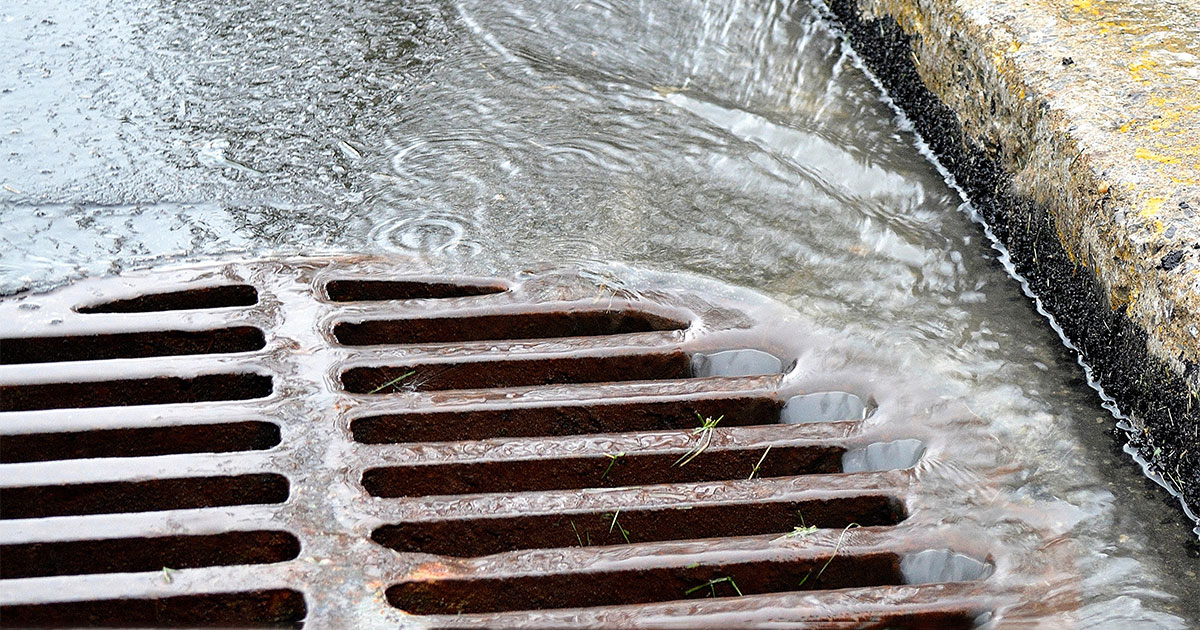
Wisconsin’s abundant water resources are remarkable. Wisconsin has 15,081 inland lakes totaling about 1.2 million acres and approximately 5 million acres of wetlands.1 Together, Wisconsin’s lakes and wetlands account for approximately 18.5% of the state’s total area. Wisconsin also has more than 12,600 rivers and streams whose combined length is more than 88,000 miles.2 But that’s not all: On average, Wisconsin communities receive approximately 37 inches per year of precipitation.3 At a time when much of the United States is experiencing water shortages, Wisconsin is fortunate to have such abundant freshwater resources.
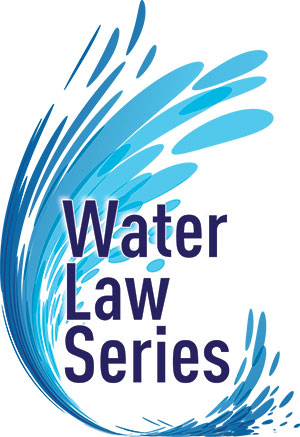
An abundance of water can be a mixed blessing. It requires that stormwater runoff be effectively managed from both a water quantity and a water quality standpoint. Stormwater can result in floods that damage urban property, farmland, roads, and other infrastructure. It can also damage streambanks, lakes, and wetlands through erosion and sediment deposit. Nutrients and sediment from agricultural runoff, and salt and other contaminants from urban runoff, are also significant sources of water quality impairment for Wisconsin’s surface waters.
These issues are becoming more concerning for at least two reasons. First, climate change is producing storms with increased frequency and intensity. The Wisconsin Center for Climatic Research has projected that rainfall and storm intensity will continue to increase over the next 50 years.4 Second, urbanized areas have grown dramatically in the last 50 years, resulting in more impervious surfaces and more disruptions to natural water flow from roads and culverts. This trend is likely to continue.
The Evolution of Stormwater Regulations
Historically, surface water was considered a “common enemy” that could be redirected with impunity.5 Some of Wisconsin’s earliest laws allowed for the creation of drainage districts to drain wetlands and surface water.6 By the 1960s, nearly one-half of Wisconsin’s wetlands were drained or developed. Well into the 1950s and 1960s, urban and rural areas alike also opted to channelize streams to allow water to drain more quickly.
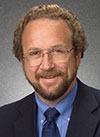 Paul G. Kent, U.W. 1981, practices with Stafford Rosenbaum LLP, Madison, in administrative and local government law and environmental law. He has taught environmental law and practice at U.W. Law School since 1989. He is a member of the State Bar of Wisconsin’s Administrative & Local Government Law Section, Environmental Law Section, and Senior Lawyers Division. He is the author of Wisconsin Water Law in the 21st Century, available at WisconsinWaterLaw.com.
Paul G. Kent, U.W. 1981, practices with Stafford Rosenbaum LLP, Madison, in administrative and local government law and environmental law. He has taught environmental law and practice at U.W. Law School since 1989. He is a member of the State Bar of Wisconsin’s Administrative & Local Government Law Section, Environmental Law Section, and Senior Lawyers Division. He is the author of Wisconsin Water Law in the 21st Century, available at WisconsinWaterLaw.com.
 Erin O’Brien is policy programs director for the Wisconsin Wetlands Association (WWA), Madison. WWA is a science-based nonprofit organization focused on wetlands conservation. WWA’s work promoting the restoration of wetlands and floodplains to improve water quality and reduce floods has led to meaningful collaborations with legislators, state agencies, local governments, agricultural groups, private landowners, and more. For more information on WWA programs and projects, visit wisconsinwetlands.org.
Erin O’Brien is policy programs director for the Wisconsin Wetlands Association (WWA), Madison. WWA is a science-based nonprofit organization focused on wetlands conservation. WWA’s work promoting the restoration of wetlands and floodplains to improve water quality and reduce floods has led to meaningful collaborations with legislators, state agencies, local governments, agricultural groups, private landowners, and more. For more information on WWA programs and projects, visit wisconsinwetlands.org.
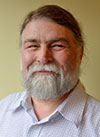 Tracy Hames is executive director for the Wisconsin Wetlands Association.
Tracy Hames is executive director for the Wisconsin Wetlands Association.
Get to know the author: Check out Q&A below.
By the 1970s, the common-enemy doctrine was overturned,7 new programs were developed, and many existing water-management programs were revised to address stormwater issues. Key programs that emerged as part of this shift included the following.
Wetlands. Section 404 of the Clean Water Act of 1972 gave the U.S. Army Corps of Engineers jurisdiction over the discharge of dredged and fill material into waters of the United States, including wetlands.8 The exact reach of Corps jurisdiction over “waters of the United States” remains a topic of dispute, but the recognition of the functional values of wetlands and the restriction of any fill into wetlands is now well established.
Wisconsin has a parallel program restricting the fill of wetlands, which encompasses both wetlands covered by federal law and other wetland areas – sometimes referred to as non-federal wetlands.9 In 1991, Wisconsin adopted water-quality standards for wetlands that identify the specific functions to be preserved, including several related to stormwater management and hydrology. The rule also includes a provision that seeks to preserve wetland functional values associated with any Wisconsin Department of Natural Resources (DNR)-permitted activity – not only discharges of fill.10 These provisions and several other federal and state laws strictly limit activities that adversely affect wetlands.11
Flood Control. In 1966, Wisconsin enacted floodplain zoning to limit construction and maintenance of structures in flood-prone areas.12 Several years later, Congress passed the National Flood Insurance Act, which requires municipalities and counties to adopt floodplain management and zoning to be eligible for flood insurance.13 The zoning is local but is supervised by the DNR with significant oversight by the Federal Emergency Management Agency. The availability of flood insurance is crucial because flood insurance is required by lenders to obtain a mortgage for any structure in “special flood hazard areas.”
Runoff Management. By the late 1980s, Wisconsin laws further evolved to recognize that stormwater affected water quality as well. Chapter NR 151 of the Wisconsin Administrative Code, titled Runoff Management, creates standards for agricultural and urban stormwater management.14
For agricultural runoff sources, chapter NR 151 performance standards are to be achieved through cost-share dollars and other incentives administered by the Department of Agriculture, Trade and Consumer Protection (DATCP) and county land-conservation departments.15 Various federal incentive programs, such as the Conservation Reserve Program (CRP), also encourage conservation practices on privately owned lands.16
For larger urban areas, chapter NR 151 provisions are enforced through stormwater permits. The DNR issues these permits, known as municipal separate storm sewer system (MS4) permits, under its Clean Water Act authority.17 At the site-development level, chapter NR 151 also establishes performance standards designed to improve infiltration, reduce peak flow and sediment-laden runoff, and protect adjacent wetland and waters both during and after construction.18 In watersheds where the receiving stream does not meet existing water-quality standards, additional requirements regarding stormwater quality might be imposed.19
Navigable Water and Dam Regulations. The regulation of structures in navigable waters and dams dates to the earliest days of statehood, and the relevant statutes are now in Wis. Stat. chapters 30 and 31.20 In the early 2000s, new regulations were promulgated for structures relating to stormwater management, such as stormwater ponds and culverts, and activities such as grading and dredging.21 Similarly, new regulations for dams were enacted in the 1980s to ensure that dams were maintained to avoid creating downstream hazards. Dam-hazard ratings are based on estimations of flood events such as so-called 100-year floods. As storm intensity increases, those metrics will be affected.22
Other Efforts. While the programs listed above represent some of Wisconsin’s most direct stormwater-management efforts, they are by no means the only state-sponsored programs with water quality or quantity objectives. Other examples include but are not limited to regulations to reduce impacts from groundwater pumping, shoreland development, and forestry practices; policies related to lake-level management; and conservation programs focused on fish and wildlife, lakes, and woodlands.
Although the DNR is central to all these efforts, the Wisconsin Department of Transportation (DOT), DATCP, Wisconsin Emergency Management, and the Wisconsin Coastal Management Program also co-manage or independently administer programs that can positively or negatively affect water quality or quantity. There are also active drainage districts, stormwater utilities, and other locally led programs that have their own objectives and authority to address stormwater.
More Regulations, More Complexity. The current approach to stormwater management is more sophisticated than in the common-enemy days. Today, there are programs to protect wetlands, control pollutants from runoff, regulate floodplains and dams, limit shoreland development, limit erosion from construction sites, and more. The problem is that these programs remain largely discrete and uncoordinated, mostly reacting to site-specific problems. In the real world, however, water resources function in complex relationships to the land and to each other across watersheds.
Such a fragmented approach is becoming even less viable as the volumes and flows of stormwater runoff increase. The challenge for the next 50 years is to figure out how to tie together all these programs to more efficiently and effectively restore the health of Wisconsin’s waters. Repairing degraded hydrology will be crucial to any such effort.
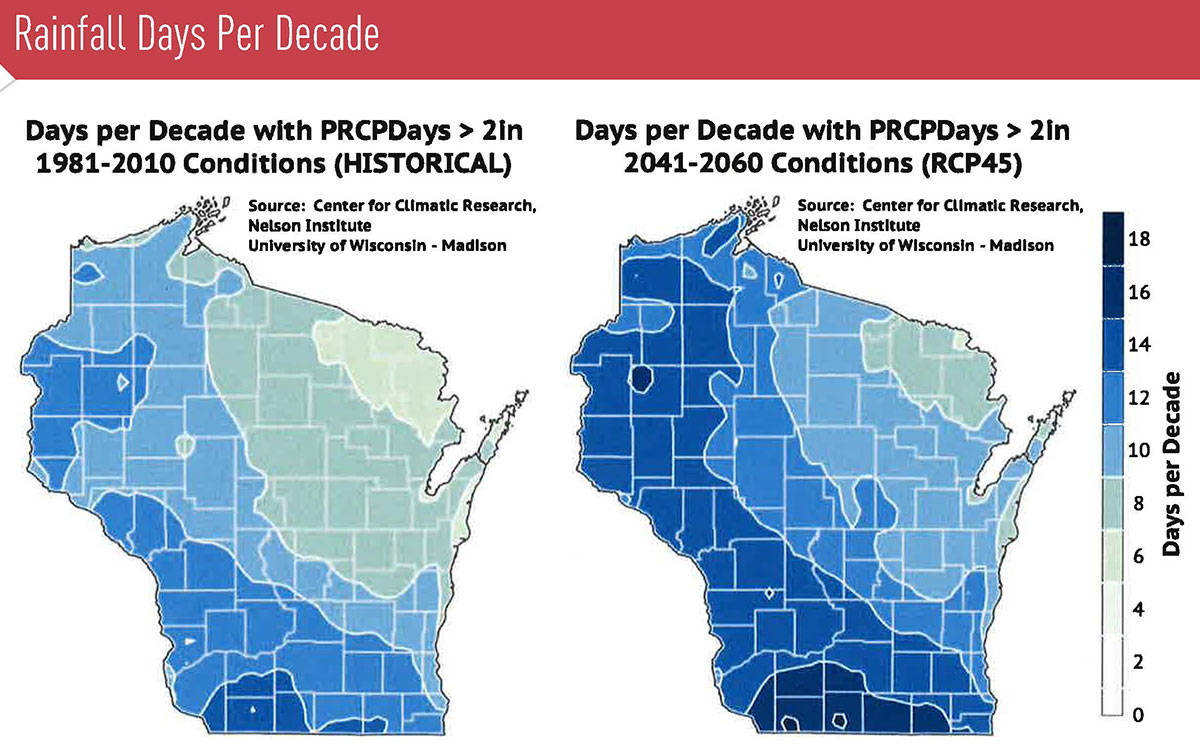
Understanding Watershed Hydrology
Hydrology 101. Two simple facts support the need for a watershed approach to runoff management: all waters are connected, and water flows downhill.
A watershed (also called a drainage basin) is all the land area draining into a single lake, stream, river, or wetland. Because all waters are connected, changes in one part of the system affect the other parts. Because water flows downhill, many small changes throughout a drainage system can accumulate to create large problems at the bottom.
The hydrologic cycle is a term that describes how water both flows across the land surface and infiltrates into the ground, ultimately discharging into lakes, rivers, and wetlands. In any given watershed, the behavior of the surface water and groundwater is informed by natural landscape characteristics such as geology, topography, soils, and the amount and intensity of precipitation.
Though watersheds are complex, they behave predictably when fundamental hydrologic processes are intact. They also decline rapidly when hydrologic processes are degraded. Some knowledge of how wetlands and rivers work and interact with each other helps in understanding these phenomena.
Wetlands in Watersheds. Wetlands play a disproportionately large role in runoff management because of the many ways they influence water movement throughout the watershed.23 During rainfall or snowmelt, water needs a place to go. Wetlands located in depressions on the landscape capture water, allowing it to slowly soak into the ground. These depressional wetlands are often abundant in the upper portions of watersheds, also known as headwaters areas. Water collected in depressional wetlands is slowly released, or soaks into the ground, traveling downslope through subsurface flow. This subsurface flow eventually makes it back to the surface water system through discharge into groundwater-fed wetlands, lakes, or streams.
Farther downstream, floodplain wetlands also provide water storage and infiltration, but their function especially kicks in when rivers rise. In well-connected systems, rising water spreads out across the adjacent floodplain where, among other things, it can slow down, drop sediment, and soak into the ground.
The combined benefits of healthy upper-watershed wetlands and floodplain wetlands working together across a watershed are many. Foremost is that they slow the flow of water. By reducing peak flows and velocity, wetlands can reduce downstream inundation, erosion, sediment transport, and infrastructure damage.
These wetland-based hydrologic processes do not just nominally help to maintain or restore water quality or quantity – they are fundamental. The accompanying Stream Functions Pyramid helps to illustrate why.24 It shows how the primary direction of cause-and-effect relationships affecting watershed health flows from the bottom of the pyramid to the top with hydrologic and hydraulic processes providing the foundation.
Hydrologic functions are those that influence the transport and delivery of water from the entire watershed to the channel system. As described above, upper-watershed wetlands factor prominently in this delivery system. Hydraulic functions dictate how water behaves in the stream itself. This includes interactions between the channel, the adjacent floodplain, and the region beneath and alongside a streambed, where mixing of shallowgroundwaterandsurface water occurs.Here again (floodplain) wetlands are fundamental to the function of the system.
As shown, Tiers 1 and 2 comprise the hydrologic processes that, when intact, create the conditions necessary to support the physicochemical and biological features of a stream. In other words, if there is a management goal at Tier 5 (that is, improved biology) or Tier 4 (that is, water quality), it is imperative to address the lower-level functions needed to meet that goal.
When these foundational tiers are not addressed, the system becomes stressed.25 So, for example, if upstream-wetlands storage is eliminated, the water those wetlands held has to go somewhere else. And so it flows downstream. When water is moved further and faster downstream by turning waterways into channels and building levees, the volume and velocity of flow increases, and erosion increases too. When these disrupted processes are widespread, as is the case in many Wisconsin watersheds, feedback loops take hold. Uncontrolled runoff cuts gullies through wetlands. These act like agricultural drainage ditches, not only removing water that might have soaked into the ground but also transporting it swiftly downstream. This causes stream beds and banks to further erode, which further disconnects streams from floodplains. Upper watersheds become drier, thus increasing the need for irrigation. Downstream areas become wetter, increasing the need for drainage. Add in more frequent and severe storms, and the system becomes more stressed.
To bring this back to policy, if regulatory performance standards and public conservation programs prioritize investments in the higher-level tiers of the pyramid while the underlying hydrology, hydraulics, and geomorphology are still impaired, interventions will not be effective or sustainable. Problems such as degraded habitat, high sediment loads, and invasive species are responses to, or made worse by, degraded hydrology. In contrast, addressing the underlying hydrologic conditions that caused the system to decline reduces the need to repeat restoration or repair efforts. This is better for the resource and makes economic sense, too.
Hydrologic Restoration. Wisconsin’s water-management efforts currently employ regulations, technologies, and best-management practices designed to “fix” site-specific problems, not the underlying hydrologic conditions. For example, the installation of a stormwater pond to meet MS4 stormwater sediment goals may have limited value in improving stream functions and almost no value in reducing flooding from major storms. Buffers filter runoff but do not control it. Moving structures out of a floodplain helps reduce certain expenses but has no effect on peak flow.
In contrast, watershed-based hydrologic restoration addresses the system as a whole, repairing the processes needed to both control runoff and restore aquatic health. For example, working upstream to increase storage and infiltration, or along rivers to reconnect floodplains, reduces the extent of downstream flooding. Such efforts also improve water quality by reducing erosion and transport of nutrients. Controlling flow and erosion are both key nutrient-management strategies. Wetlands excel at both.26
A 2021 evaluation facilitated by the University of Wisconsin Extension in collaboration with the Wisconsin Wetlands Association, the DNR, and DATCP concluded that restoring hydrology could help address many of Wisconsin’s water-management challenges and that designing projects without adequately considering hydrologic context results in failed projects.27 This evaluation also found that Wisconsin’s policies and programs are not structured to support watershed-scale hydrologic assessment and restoration work.
The evaluation identified many barriers, including a lack of data and decision-support tools, lack of technical expertise and design support, and funding constraints that favor site-specific projects and predetermined practices. This differs from hydrologic assessment and restoration, which require identification of degraded hydrology at watershed scale and allow flexibility in the location and design of restoration practices. It also takes planning.
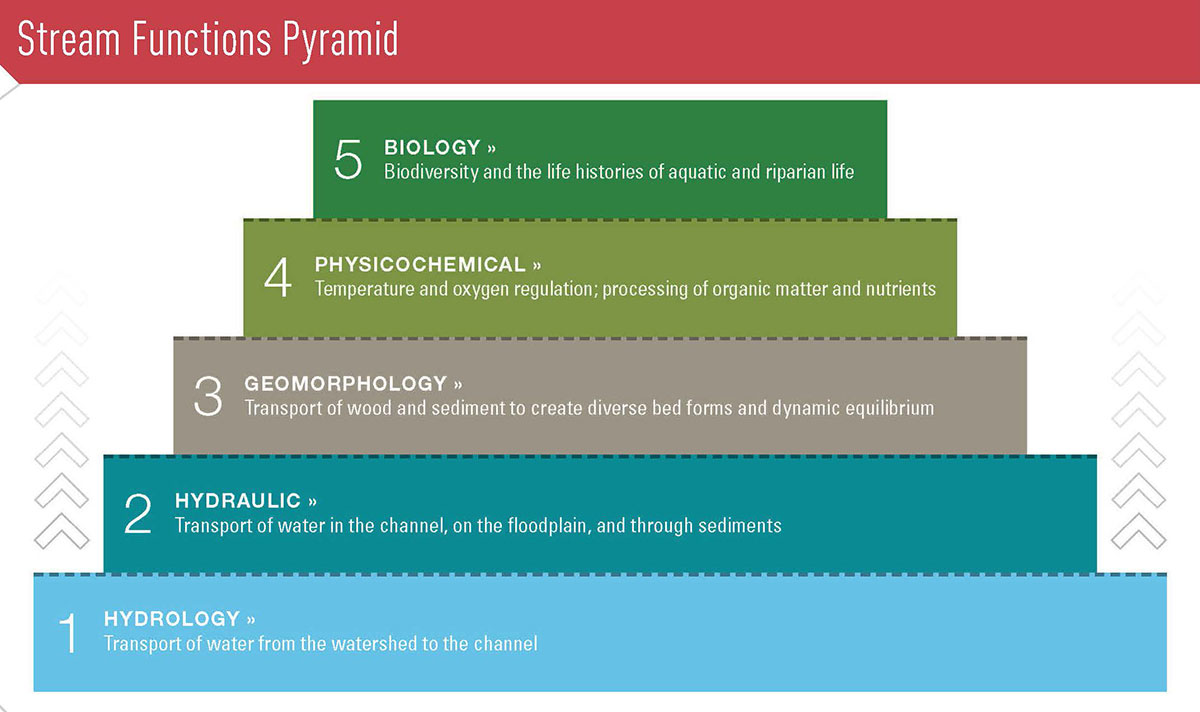
Watershed Based Approaches
Given this information about watersheds, a primary issue is how to effectively manage the increasing challenges of stormwater runoff within an existing regulatory framework comprised of discrete programs.
At the outset, there must be a greater recognition that watershed approaches are often more effective in terms of results and cost. This realization requires a change in mindset and objectives. Wisconsin residents and communities must shift from relying wholly on engineered infrastructure focused on treatment or containment to incorporating more hydrology-focused practices designed to restore functions; from projects designed for a single purpose to projects that can provide multiple watershed benefits; and from policies focused on preventing harm to policies that incentivize restoring health.
Investments in new programs would help, but many opportunities exist to bring current programs into better alignment.
Use Existing Regulatory Flexibility. Each discrete regulatory program has its own set of requirements. Often those requirements have been narrowly defined in ways that limit watershed-scale approaches. But some standards are broad enough to allow watershed projects to proceed.
For example, current law prevents filling of wetlands where there is a practicable alternative to the fill. This can get complicated in a runoff-management context, particularly on highly degraded sites where otherwise beneficial work may require some wetland disturbance. Examined as part of an entire site design with larger objectives in mind, however, the impact may be acceptable. This approach is supported by a provision enacted in 2012 that requires the DNR to consider “the net positive or negative environmental impact of the proposed project.”28 In other words, sometimes the practicable-alternatives test must be viewed in the context of larger watershed benefits. The Wetland Study Council currently is examining some of these considerations.29
Recently enacted legislation requiring the DNR to develop a general permit for hydrologic restoration is an example of a law providing flexibility in the type and location of practices for situations in which a project improves hydrologic processes.30
Align Nonregulatory Programs. For every water-management issue that is regulated, the state runs parallel programs designed to encourage or support voluntary restoration or recovery work. Prominent examples include the DNR’s surface water and municipal flood control grants programs, DATCP’s soil and water resource management program, and DOT programs providing assistance for culvert design or post-disaster road repair. The state also employs biologists, engineers, scientists, and other individuals who directly manage public lands and waters, develop data and decision-support tools to support environmental decision-making, or oversee the design and construction of restoration projects. Modest adjustments in these programs could increase integration of watershed-informed hydrologic restoration in state-sponsored work.
On the funding side, policy makers should acknowledge the economic value of projects that achieve multiple benefits and look for creative ways to strengthen financial incentives for practices that restore hydrologic processes.31 Opportunities may exist to combine payments from multiple credit-based programs or to expand programs such as the Clean Water Fund to encourage upstream projects that have downstream benefits.
Leverage Municipal Resources and Authority. Municipalities have a unique role within the stormwater regulatory context. On the one hand, they are regulated entities that must comply with state and federal mandates – MS4 permits together with TMDLs and NR 151 stormwater management requirements, floodplain zoning requirements, and Wis. Stat. chapter 30 permits. On the other hand, they operate utilities that regulate and manage wastewater and stormwater from residences and businesses. They have an independent interest in ensuring that their communities and infrastructure are safe from flooding, that local drinking water is safe, and that surface waters support local recreation and tourism. And municipalities are uniquely positioned to define local water-management objectives and establish partnerships to address shared goals.
These interests and authorities provide numerous opportunities to consider hydrologic restoration and watershed planning in designing and approving projects. Examples include the extension of urban service areas for sewer and water, managing surface water flows into sanitary and storm sewers, maintaining compliance with MS4 permit requirements, and alternative compliance options for meeting phosphorus water-quality standards. Often, these opportunities can improve water quality or supply, or reduce flood risk at a much lower cost. For example, under the Greenseams® program,32 the Milwaukee Metropolitan Sewerage District (MMSD) has purchased areas for infiltration in headwaters areas and floodplains and worked to place concrete-lined channels back into more natural meanders, all of which help reduce flooding and improve water quality. Another example is the village of Plover’s Little Plover River Watershed Enhancement Project.33
Recognize the Need for Coordination. Discrete regulatory and funding programs are a reality. These programs are administered by separate agencies often including federal, state, and local authorities. Even within the DNR, there are separate programs for wetlands and waterways, floodplain zoning, and stormwater. With no state programs dedicated to watershed-based hydrologic assessment or restoration, the coordination burden currently falls on entities seeking to undertake projects. To encourage this work at meaningful scales, state agencies should develop ways to help facilitate coordination and provide technical support for watershed-informed hydrologic restoration.
Conclusion
The challenges of managing water abundance – in particular stormwater runoff – are increasing. Successful approaches to meet those challenges require holistic watershed-based approaches. The measures of success should be whether and how well runoff-management controls and programs contribute to the health of Wisconsin’s waters and to the health, safety, and welfare of Wisconsin’s communities. Watershed-scale hydrologic restoration provides the soundest answer to this question by improving water quality, reducing floods, protecting vulnerable infrastructure, improving fish and wildlife habitat, and reducing the need for ever-more onerous regulations.
Meet Our Contributors
What is the most rewarding part of your job?
 I love solving problems and reaching collaborative solutions. I have been fortunate to practice in environmental law because it exists in a dynamic setting that requires creative and collaborative approaches. The laws written in the 1970s, much less the 1870s, do not always address the problems of today. Sometimes it requires changes in the statutes, such as laws that allow point sources to get credit for curbing non-point pollution. Sometimes it requires the administrative agencies to read existing statutes broadly rather than narrowly, such as the net environmental benefit language in the wetlands law discussed in my article in this issue. Sometimes it requires that all three levels of government be brought to bear in solving a land use matter – whether that is a stormwater issue or the siting of a solar farm. It’s not easy, but the governmental-affairs nature of environmental law provides a dynamic legal platform from which to find real solutions to the challenges of the natural environment. When that happens, it is very rewarding.
I love solving problems and reaching collaborative solutions. I have been fortunate to practice in environmental law because it exists in a dynamic setting that requires creative and collaborative approaches. The laws written in the 1970s, much less the 1870s, do not always address the problems of today. Sometimes it requires changes in the statutes, such as laws that allow point sources to get credit for curbing non-point pollution. Sometimes it requires the administrative agencies to read existing statutes broadly rather than narrowly, such as the net environmental benefit language in the wetlands law discussed in my article in this issue. Sometimes it requires that all three levels of government be brought to bear in solving a land use matter – whether that is a stormwater issue or the siting of a solar farm. It’s not easy, but the governmental-affairs nature of environmental law provides a dynamic legal platform from which to find real solutions to the challenges of the natural environment. When that happens, it is very rewarding.
Paul G. Kent, Stafford Rosenbaum LLP, Madison.
What is the most challenging or rewarding part of your job?
 At Wisconsin Wetlands Association, we like to talk about protecting and restoring wetlands to solve problems. It’s rewarding to be working with farmers, local governments, emergency managers, state program managers, policy makers, and others to explore wetlands as solutions to the issues they care about. The work is certainly complex.
At Wisconsin Wetlands Association, we like to talk about protecting and restoring wetlands to solve problems. It’s rewarding to be working with farmers, local governments, emergency managers, state program managers, policy makers, and others to explore wetlands as solutions to the issues they care about. The work is certainly complex.
With the majority of Wisconsin’s wetlands in private ownership, people’s ideas on how they should be used or managed are as diverse as the wetlands themselves. It takes a lot of time and patience to understand everyone’s perspectives and to identify common ground. But once those pathways become clear, positive and unexpected things can happen ... barriers dissolve and complex issues become less intractable. It’s exciting to be working so collaboratively to improve wetland policies and practices in Wisconsin, and we’re eager to expand these collaborations in the coming years.
Erin O’Brien, Wisconsin Wetlands Association, Madison.
What is your favorite place in Wisconsin?
 Any time I have my feet in the water and mud of a wetland, that wetland becomes my favorite place. Wisconsin is home to an incredible diversity of landscapes and the wetlands they contain – deep sphagnum bogs, spring-fed seeps, wild-rice beds, beaver-created sloughs, waterfowl-producing marshes, broad gallery floodplain forests, grass and sedge meadows, ephemeral headwater ponds, coastal ridge-and-swale wetlands, and many more. Every wetland is unique, and each exhibits beauty in its own way. When you work for Wisconsin’s diverse wetland resources, the exploration and discovery of new favorite places never ends. I invite you all to “get your feet wet” in a wetland soon.
Any time I have my feet in the water and mud of a wetland, that wetland becomes my favorite place. Wisconsin is home to an incredible diversity of landscapes and the wetlands they contain – deep sphagnum bogs, spring-fed seeps, wild-rice beds, beaver-created sloughs, waterfowl-producing marshes, broad gallery floodplain forests, grass and sedge meadows, ephemeral headwater ponds, coastal ridge-and-swale wetlands, and many more. Every wetland is unique, and each exhibits beauty in its own way. When you work for Wisconsin’s diverse wetland resources, the exploration and discovery of new favorite places never ends. I invite you all to “get your feet wet” in a wetland soon.
Tracy Hames, Wisconsin Wetlands Association, Madison.
Become a contributor! Are you working on an interesting case? Have a practice tip to share? There are several ways to contribute to Wisconsin Lawyer. To discuss a topic idea, contact Managing Editor Karlé Lester at (800) 444-9404, ext. 6127, or email klester@wisbar.org. Check out our writing and submission guidelines.
Endnotes
1 Wis. DNR, Wisconsin’s Water Quality Report to Congress, https://dnr.wisconsin.gov/topic/SurfaceWater/Congress.html (last visited April 15, 2022); Wis. DNR,Wisconsin Wetlands: Acreage Facts, https://dnr.wisconsin.gov/topic/Wetlands/acreagefacts.html (last visited April 15, 2022).
2 See sources cited in note 1, supra.
3 Statewide annual average precipitation for 2010-2019 was 37.0 inches, a 17% increase over the previous long-term average. Wis. Initiative on Climate Change Impacts, Wisconsin’s Changing Climate: Impacts and Solutions for a Warmer Climate 12 (2021), https://wicci.wisc.edu/2021-assessment-report/full-report/.
4 Id.
5 Borchseniusv. Chicago, St. Paul, Minneapolis & Omaha R. Co., 96 Wis. 448, 450, 71 N.W. 884 (1897).
6 Territorial Laws of 1839, An Act concerning fences and fence viewers, § 12; 1862 Wis. Laws ch. 398; 1871 Wis. Laws ch. 64. In 1994, the drainage laws were substantially reorganized and DATCP and the DNR were given greater oversight authority over county-administered drainage boards. 1993 Wis. Act 456.
7 The common-enemy rule was abandoned in State v. Deetz, 66 Wis. 2d 1, 224 N.W.2d 407(1974).
8 33 U.S.C. § 1344.
9 Wis. Stat. § 281.36; seealso Paul G. Kent & Jordan K. Lamb, Wisconsin’s Wetland Reform Act, 86 Wis. Law. No. 1 (Feb. 2013).
10 Wis. Admin. Code ch. NR 103; see also Wis. Admin. Code § NR 1.95.
11 For example, the so-called Swampbuster provisions of the Food Security Act limit the eligibility of farmers to certain programs if they convert wetlands into farmlands. 16 U.S.C. § 3821. On the state level, a program requires restrictive zoning of wetlands within shorelands, Wis. Admin. Code § NR 115.04, and the creation of protective zones (that is, buffer areas) associated with construction sites, Wis. Admin. Code § NR 151.125.
12 Wis. Stat. § 87.30.
13 42 U.S.C. § 4022 (part of the National Flood Insurance Act).
14 Wis. Stat. § 281.16.
15 Wis. Admin. Code §§ NR 151.01-.097 (Agricultural Performance Standards and Prohibitions); Wis. Admin. Code ch. ATCP 51.
16 CRP is a land conservation program administered by the Farm Service Agency. See 7 C.F.R. pt. 1410. In exchange for a yearly rental payment, farmers enrolled in the program agree to remove environmentally sensitive land from agricultural production and to plant species that will improve environmental health and quality.
17 Wis. Stat. § 283.33; Wis. Admin. Code § NR 216.08. Information about the MS4 General Permit is at https://dnr.wisconsin.gov/topic/Stormwater/municipal/overview.html.
18 See Wis. Admin. Code §§ NR 151.10-.14 (Non-Agricultural Performance Standards).
19 In places where the receiving water is “impaired,” a total maximum daily load (TMDL) may be developed and if so, the TMDL allocation would be reflected in the MS4 permit requirements.
20 For a history of these laws, see Paul G. Kent, Wisconsin Water Law in the 21st Century chs. 2, 3 (2013).
21 See,e.g., Wis. Admin. Code chs. NR 343 (ponds), NR 341 (grading), NR 320 (culverts), NR 345 (dredging).
22 Wis. Stat. § 31.19. Wisconsin Administrative Code section NR 333.06 establishes the criteria for hazard ranking, and section NR 333.07(1) establishes the minimum hydraulic capacity based on those rankings.
23 A video that explains how wetlands manage water is at www.wisconsinwetlands.org/learn/about-wetlands/benefits-of-wetlands/.
24 Will Harman et al., A Function-Based Framework for Stream Assessment and Restoration Projects, U.S. EPA Off. of Wetlands, Oceans & Watersheds (May 2012), https://streammechanics.egnyte.com/dl/cde14b2bb9f2456d;https://stream-mechanics.com/stream-functions-pyramid-framework/.
25 Wis. Wetlands Ass’n,Our Legacy of Wetland Loss: Behind our Water Problems (Oct. 13, 2020),www.wisconsinwetlands.org/updates/our-legacy-of-wetland-loss-behind-our-water-problems/.
26 Amy T. Hansen et al., Contribution of Wetlands to Nitrate Removal at a Watershed Scale, Nature Geosci. 127-32 (Feb. 2018), https://doi.org/10.1038/s41561-017-0056-6.
27 Examining the Status of Hydrologic Assessment and Hydrologic Restoration in Wisconsin. More than 30 individuals including technical experts and managers of state and local water management programs participated. www.wisconsinwetlands.org/wp-content/uploads/2021/11/Final-FG-report-11.22.21.pdf.
28 Wis. Stat. § 281.36(3n)(b)5.
29 See Wis. DNR, Wisconsin Wetland Study Council,https://dnr.wisconsin.gov/topic/Wetlands/studyCouncil.html (last visited April 14, 2022).
30 2021 Wis. Act 77.
31 Under 2019 Wis. Act 157, the Wisconsin Legislature appropriated $150,000 from the urban nonpoint sources and storm water management grant program to Ashland County for up to three demonstration projects that test natural flood-risk-reduction practices. The legislation requires the DNR to report to the legislature and the Division of Emergency Management summarizing project results and how existing state policies or funding streams could be adapted to create incentives to protect and restore natural infrastructure and reduce floods.
32 MMSD: Partners for a Cleaner Environment, What We Do, www.mmsd.com/what-we-do (last visited April 14, 2022).
33 The Little Plover River Watershed Enhancement Project is a watershed-scale, interdisciplinary collaboration focused on conserving groundwater and restoring flows to the Little Plover River. See Vill. of Plover Wis., Little Plover River Watershed Enhancement Project, www.ploverwi.gov/328/Little-Plover-River-Watershed-Enhancement (last visited April 14, 2022).
» Cite this article: 95 Wis. Law. 20-26 (May 2022).
